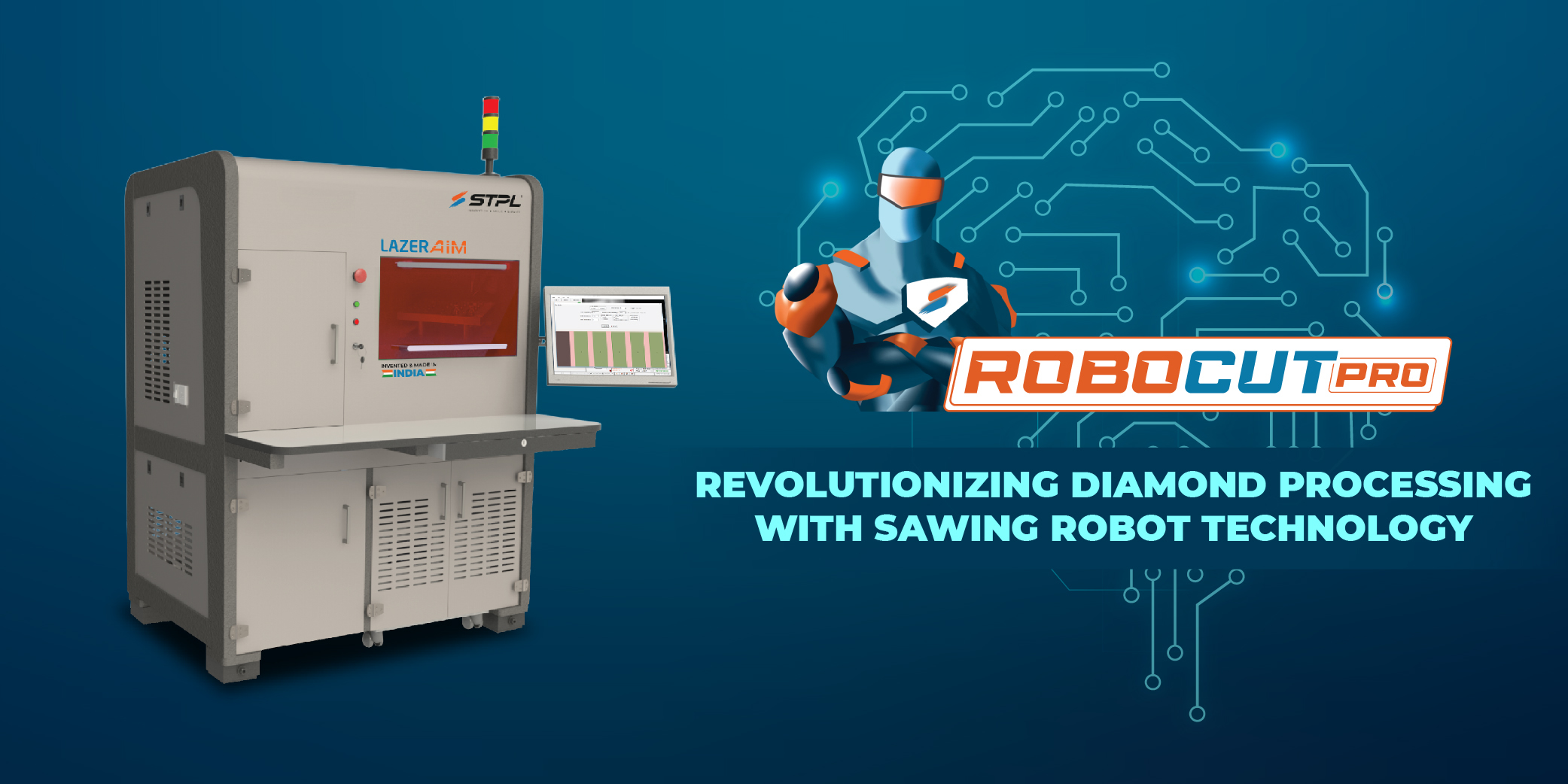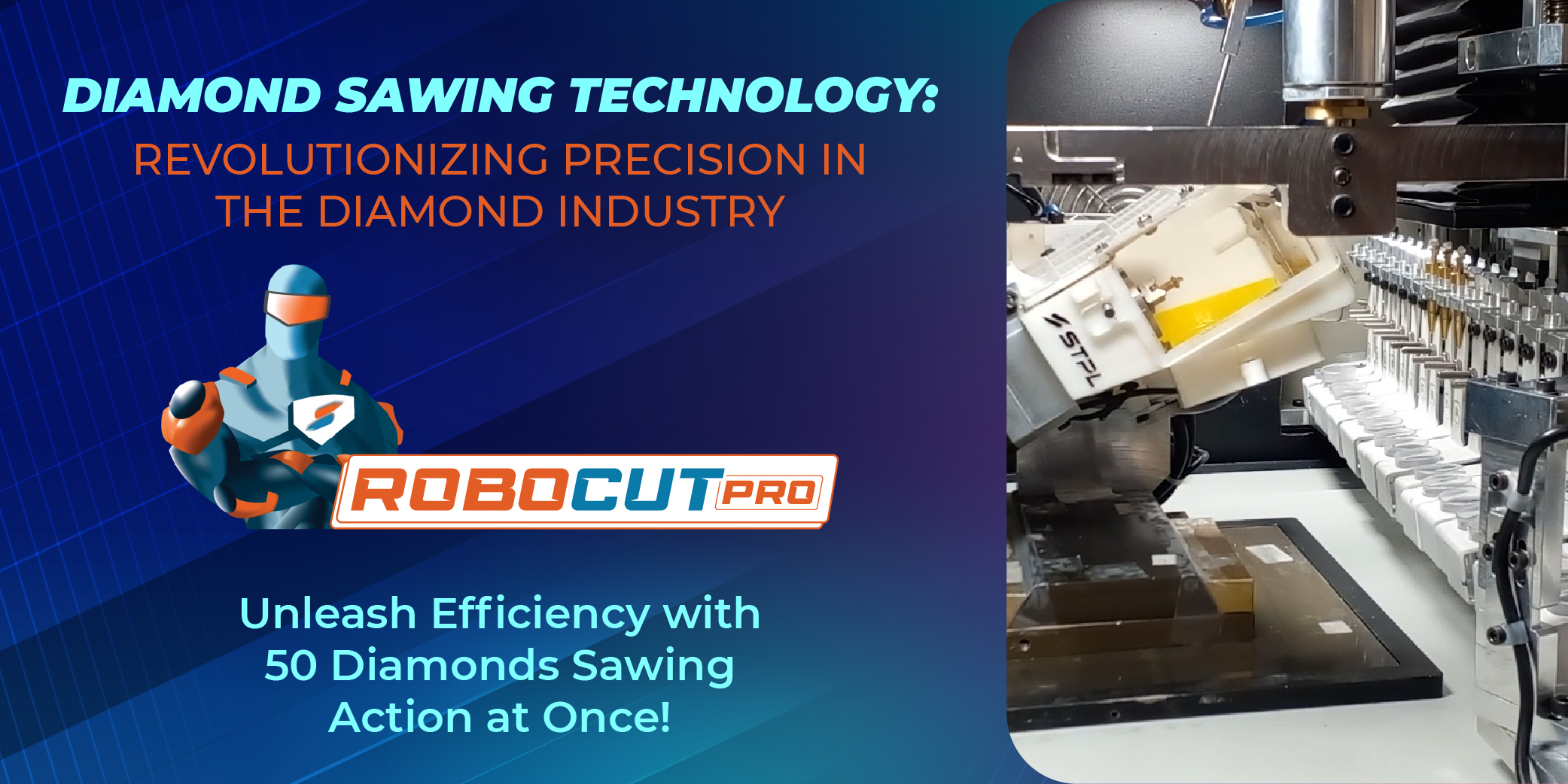Diamond sawing is one of the most critical processes in the journey from rough diamond to polished brilliance. As the demand for flawless diamonds grows globally, advancements in diamond sawing technology have become paramount to the diamond industry’s efficiency, profitability, and sustainability. At STPL, we pride ourselves on being at the forefront of this technological revolution, developing machines and technologies that optimize the diamond cutting process, reduce waste, and improve overall yield. The introduction of sophisticated sawing systems, such as our LAZER AIM and MagikCut, has redefined how diamonds are cut, ensuring precision, accuracy, and minimal breakage.

The Importance of Diamond Sawing
Sawing is an essential step in the diamond cutting process, determining the size, shape, and future value of the diamond. Diamonds are incredibly hard, ranking at 10 on the Mohs scale, which makes them difficult to cut. While diamond is the hardest naturally occurring substance on Earth, it is also brittle, which means that if not cut correctly, it can break, resulting in loss of carat weight and value. Sawing, therefore, plays a crucial role in minimizing material loss while maximizing the quality of the cut diamond.
Traditional diamond sawing methods relied heavily on manual labour and rudimentary tools, which led to considerable losses due to breakage and poor cutting accuracy. However, with the advent of modern diamond sawing technology, the process has become more streamlined and efficient, drastically reducing the risk of breakage while ensuring optimal yield.
Evolution of Diamond Sawing Technology
The diamond industry has witnessed significant advancements in sawing technology over the years. Early sawing techniques, such as cleaving and bruting, involved manually cutting or shaping diamonds. These methods, while effective for their time, were prone to human error and resulted in substantial diamond loss. As the diamond market expanded and consumer demand for precision-cut stones grew, the need for more advanced technology became evident.
The introduction of mechanized saws marked a turning point in the diamond industry. Initially, diamond saws used metal blades embedded with diamond particles to cut through rough stones. While these saws improved accuracy, they still posed risks of breakage and overheating. The challenge was to find a sawing technology that could cut diamonds efficiently without compromising their integrity.
With the rise of laser technology in the 20th century, diamond sawing took a quantum leap forward. Lasers offered unprecedented precision, allowing for intricate cuts that were previously impossible with traditional methods. Lasers reduced the amount of material lost during the cutting process, increased the speed of cutting, and minimized the risk of breakage. This innovation paved the way for further advancements in diamond processing, including the development of computer-aided design (CAD) and automated sawing machines.

Laser Sawing: A Game-Changer
Today, laser sawing is the industry standard for diamond cutting. Lasers use focused light beams to cut through diamonds with incredible accuracy. The primary advantage of laser sawing is its ability to make precise cuts while minimizing the amount of diamond material lost during the process. The laser's precision also reduces the risk of breakage, which is a common issue with mechanical sawing methods.
One of the key innovations in laser technology is the ability to perform multipie sawing, a process that allows multiple cuts to be made simultaneously. This technique significantly reduces the time it takes to saw a rough diamond and increases the overall yield by ensuring that more diamonds can be produced from a single stone. Multipie sawing also helps to minimize diamond breakage, as the laser's heat is concentrated in a small area, reducing the risk of thermal shock to the diamond.
STPL’s LAZER AIM and MagikCut machines are prime examples of how laser sawing technology has revolutionized the diamond cutting process. These machines utilize advanced laser systems to ensure that each cut is made with the highest level of precision. The laser’s beam quality, stability, and focus are crucial to achieving flawless cuts, especially when dealing with high-value stones like fancy diamonds or large rough stones.
Precision in Fancy Shapes and Customized Diamonds
As consumer demand for customized diamonds continues to rise, laser sawing technology has adapted to meet these requirements. In today’s market, diamond buyers are not just interested in traditional round-cut diamonds; there is a growing demand for fancy shapes, such as princess, oval, pear, and heart-shaped diamonds. Laser sawing allows diamond manufacturers to create these intricate shapes with ease and precision, ensuring that the final product meets the exact specifications of the client.
The ability to customize diamond shapes has opened new markets for the diamond industry. Jewellers and consumers alike appreciate the flexibility that laser sawing offers, allowing for more creativity in jewellery design. Additionally, laser sawing enables diamond manufacturers to maximize the yield from each rough stone, ensuring that no material goes to waste. By optimizing the cutting process, laser sawing helps to reduce the environmental impact of diamond mining and processing.
Reducing Diamond Breakage with Advanced Technology
One of the most significant challenges in diamond sawing is preventing breakage. When a diamond breaks during the cutting process, it can result in a substantial loss of value, as the stone’s weight and quality are diminished. Advanced laser sawing technology addresses this issue by using controlled heat and focused energy to cut through the diamond without causing it to crack or shatter. STPL’s MagikCut technology is specifically designed to minimize diamond breakage during the sawing process. By utilizing a finely tuned laser system, MagikCut ensures that each cut is made with the utmost precision, reducing the risk of thermal shock and mechanical stress on the diamond. This results in a higher yield of usable diamond material, as well as improved overall quality in the final product.
Automation and Robotics in Diamond Sawing
The future of diamond sawing lies in automation and robotics. At STPL, we have integrated robotic technology into our diamond sawing machines to further enhance the efficiency and accuracy of the cutting process. Machines like our Robocut system are designed to handle diamonds autonomously, from loading to sawing, reducing the need for human intervention and ensuring consistent results.
Robotic sawing machines are equipped with advanced sensors and software that analyze each diamond before cutting. This analysis helps the machine determine the optimal cutting strategy, taking into account factors such as the diamond’s shape, size, and internal inclusions. By automating this process, robotic sawing machines reduce the risk of human error and ensure that each diamond is cut to perfection.
The Future of Diamond Sawing
Diamond sawing technology has come a long way from the manual methods of the past. Today’s laser and robotic sawing systems offer unparalleled precision, efficiency, and reliability, making them indispensable tools for the diamond industry. As consumer demand for customized diamonds and fancy shapes continues to grow, advancements in sawing technology will play a crucial role in meeting these needs.
At STPL, we are proud to lead the way in diamond sawing technology, offering cutting-edge solutions that help our clients maximize yield, reduce waste, and minimize breakage. With our LAZER AIM and MagikCut machines, diamond manufacturers can achieve unparalleled results, ensuring that each diamond reaches its full potential in terms of value and quality. As the industry continues to evolve, we remain committed to pushing the boundaries of what is possible in diamond processing technology.